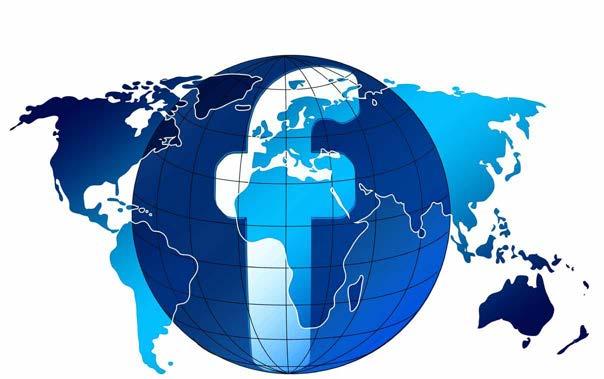
14 minute read
INFLUENCER MARKETING
›Facebook remains a popular channel for influencer campaigns because of its in-built influencer performance tools
outperforms brand-led content, there is an almost insatiable appetite for it on the continent.
He adds that Nfinity is increasingly working with influencers from Kenya, Nigeria, Tanzania, Ghana and Botswana. “Although the market is not yet as sophisticated as South Africa’s, they are catching up quickly,” Groenewald observes.
That said, it can be difficult to stand out in an oversaturated market, according to social media expert and influencer Lindo Myeni. He says that to be successful influencers should be early adopters, identify a niche, and “go the extra mile with a smile” in every campaign, since brands shy away from influencers who fail to meet expectations.
Farah Fortune, MD of African Star Communication, says that platforms to watch include rising star TikTok, Twitter Spaces (which competes with social audio app Clubhouse), Instagram Reels, social video platform Triller, and social live-streaming start-up Caffeine, in which 21st Century Fox invested US$100-million in 2018.

Combine content and performance marketing
According to Groenewald, Facebook and Instagram remain popular channels for campaigns because of their inbuilt influencer performance tools. “Combining influencer content with performance marketing was a game changer and a huge contributor towards the growth of influencer marketing,” he says.
Anne Dolinschek, founder of specialist agency Nflu#ntial, predicts that Twitch will become a big contender in the future. She also believes that influencers will increasingly become ‘shopfronts’ for e-commerce brands and generate direct sales through live steams.
“This is working well in other parts of the world, like China, and influencers are incredibly powerful when selling their favourite brand items to their audiences,” she states. “This may be some way off for the local industry, but it’s definitely on the horizon.”
A range of influencer marketing tools makes it easier to put together costeffective campaigns that are quick to execute and easy to measure. “The industry has moved on from reach and engagement,” Groenewald says. “Today, we measure campaigns on real business metrics like the cost of website traffic created, accounts
PIXABAY AND WIKIPEDIA PHOTOS: opened, apps downloaded and e-commerce sales value, depending on campaign objectives.”
Chick notes that influencer remuneration generally follows one of three methods: a trade exchange, a combination of merchandise and money, or a paid-for campaign. With influencer marketing tools making it possible to ‘grade’ influencers, many now have rate cards based on their perceived PR value, which can vary enormously.
“In South Africa, nano, micro- or macro-influencers on an influencer marketing platform can earn between R500 (US$35) and R60 000 (US$4 200) per post, depending in the campaign,” says Myeni, who adds that celebrity influencers elsewhere in Africa can earn millions. A good example is Egyptian footballer Mohamed Salah, who may earn upwards of US$175 000 per post.
In South Africa, celebrity influencers like Bonang Matheba, Minnie Dlamini and Boity Thulo can charge up to six figures for a sponsored post. Myeni says Social BlueBook is a useful resource when it comes to determining what an influencer might charge.
BEWARE THE DOWNSIDES OF INFLUENCER MARKETING
Influencer marketing is not without its detractors, however. From campaigns gone wrong (like the ill-conceived Pepsi ad featuring reality TV star Kendall Jenner, which trivialised the Black Lives Matter protests) to outright fraud (the non-existent 2017 Fyre Festival promoted by influencers and celebrities), there are hundreds of examples of ‘marketing fails’ that undeniably hurt brands and influencers alike, Fortune magazine says.
The 2020 Face Value Report, based on research conducted by multinational consultancy Duff & Phelps, shows that almost a quarter of fast-moving consumer goods brands in Europe, the UK and the United Arab Emirates have suffered a US$100 000 -US$250 000 loss from negative influencer experience.
Then there are companies that come under fire for paying influencers to sway public opinion on political or social matters. For example, South African Breweries paid influencers like Khanyi Mbau to criticise a recent lockdownrelated alcohol ban without mentioning
Influencers are not heavily regulated
the Twitter posts were sponsored. In addition, ‘finfluencers’ have come under fire for promoting cryptocurrency scams and offering unlicensed financial advice.
The industry is not heavily regulated. The Advertising Regulatory Board (ARB) in South Africa has a Social Media Code and will reprimand agencies and large companies for misdemeanours, but Van der Westhuizen says that microinfluencers who miss tagging a post with #Ad or #Sponsored are unlikely to be censured.
Globally, Webfluential’s e-book The Rules and Regulations of Sponsored Content can be downloaded by anyone – but self-regulation is notoriously problematic, and only two African countries are members of the International Council for Ad Self-Regulation: South Africa and the Democratic Republic of Congo (DRC).
“There are still marketers and influencers who don’t follow regulations,” says Dolinschek. “This has proved to be a big reputational risk during the past two years.”
Critics of influencer marketing contend that a lack of transparency, accountability and due diligence will expose brands and influencers alike to reputational and financial risk. “There is always some level of risk associated with ‘human’ channels,” says Groenewald.
“The question should be how to mitigate that risk to acceptable levels, and what plans should be put in place in case something does go wrong. It is always better to engage with industry experts whose core offering is influencer marketing. They have the know-how to assist brands and help them find their feet in the space,” he believes.
Fiona Zerbst has worked as a journalist and editor for more than 20 years. She writes primarily about business and finance and has worked for publications and clients in South Africa, Botswana, Zambia, Nigeria, Canada, Finland and the UK.
›Influencer platforms to watch include rising star TikTok
Promising outlook for Africa’s advertising industry post-lockdowns
While the challenges faced by the continent’s ad sector due to Covid are considerable, Aurelia Mbokazi finds there are upsides too.

THE GLOBAL ADVERTISING industry was severely impacted when industries such as entertainment, tourism and travel, and FMCG were hit hard by rolling lockdowns during 2020 and the first part of 2021.
However, silver linings for the sector have emerged – not least from the increased online migration by consumers – with platforms such as Google, Facebook, Snapchat and TikTok posting record advertising revenues during the first half of 2021, as reported by e-consultancy.com.
While not spared the dire effects of the pandemic, the pan-African advertising industry has innovated and moved in new directions that promise revenue growth and fresh, smarter, ways of working.
ETHIOPIA AVOIDS THE BRUNT
Serving a population of just under 120-million with an economy that grew at 6,1% in 2020 despite the Covid-19 pandemic and emerging conflict in the Tigray region, Ethiopia opted against strict lockdowns in favour of keeping the economy active.
According to Yasser Bagersh, group CEO of Cactus Communications – Ethiopia’s largest communication network comprising six companies with a staff complement of almost 600 spread across 11 offices – the group only closed its offices for three weeks in April 2020.
To mitigate the impact of Covid-19 and safeguard jobs, management established two daily shifts to allow for adequate social distancing while creative teams continued to collaborate and co-create in shared office spaces.
“The creative process requires that people sit together and scribble on walls. When we worked remotely for three weeks our creative teams opted to return to the office for in-person meetings and collaborations,” he explained.
While the group worked seamlessly on a hybrid model, management had to factor in safety protocols that were imposed by their global clients and

Sylvester Chauke of DNA Brand Architects.
had to align their working schedules to those of their clients.
Ultimately, the government’s decision to keep the Ethiopian economy open worked in their favour.
“We were not drastically affected by Covid-19 because most of our clients maintained their contracts, [but] with slight adjustments. We also dipped into our savings and retained all our employees and did not reach the stage of questioning if we should keep our offices [operating] – unlike many companies in other parts of the world,” said Bagersh.
He also noted potential cross-border agency collaborations, outsourcing of services and access to international talent as being previously out-ofreach benefits that have arisen from the pandemic.
“We’ve been contacted by highly qualified talent from around the world who lost jobs. These are individuals we typically would not be able to afford, yet the pandemic opened up opportunities to have them on board as freelancers,” he revealed.
LOST REVENUE IN NIGERIA
Emmanuel Nwafor, MD of Alternative Adverts Network Services Ltd, a digital advertising agency based in the Nigerian city of Lagos, told Strategic Marketing for Africa that, like Ethiopia, Nigeria’s lockdowns were relatively mild and therefore favourable to most economic activities.
Despite this, Nwafor said the country’s marketing sector lost over 50% of its revenue when clients shelved campaigns that had been budgeted in 2020, and resumed briefing their agencies only at the beginning of 2021.
“Transitioning to online platforms for meetings was not easy for staff and our clients who were used to having us around a table,” he recalls. “Strategy meetings that used to require two meetings stretched to three to four meetings on Zoom due to challenges associated with online connectivity.
“However, we all adjusted to the situation and were grateful to avoid Lagos’ traffic jams [and the] delays of up to four hours spent travelling to and from just one meeting,”
Transitioning to online platforms wasn’t easy


Nwafor added that the agency had been delighted to find that it is cheaper and more productive to do business online.
He noted that the growth of digital marketing in Nigeria, influenced by increased uptake by Nigerians of e-commerce businesses, resulted in improved internet connectivity and other opportunities for the industry.
As an example, Alternative Adverts Network Services created its own digital platform that enabled clients to pay for services on global platforms such as Google, Instagram and Facebook with the local naira currency, rather than the US dollar which is restricted in that market.
Nwafor said the pandemic also opened up easier opportunities for cross-regional agency collaborations and, in the second quarter of 2021, he received three to four proposals from agencies based in South Africa and Kenya wanting to explore partnerships – without having to hop from one country to another for discussions.
SA INDUSTRY’S BIG SETBACK
Karabo Songo, CEO of Brave group – a mid-sized South African agency – said the country’s stringent lockdown regulations had set the advertising industry back 10 years. Many agencies were fighting for survival and new market entrants were among the hardest hit as they struggled to build sustainable businesses.
Despite the setbacks, Songo pointed to lockdowns contributing to the emergence of new ways of doing business that have the potential to transform the local industry.
“We have fast-tracked the mind of the customer to work on digital platforms in order to deliver projects. We can also play around with talent based in different locations while working on one project,” explained Songo. “This [has] opened the marketplace to new resources and teams outside South Africa – allowing clients to consult with anyone they believe can deliver value. These are just some of the positives of Covid-19.”
LATE PAYMENTS, SMALLER BUDGETS
Founder and chief architect of Johannesburg-based DNA Brand Architects, Sylvester Chauke, said the agency had expectations of doubling its annual revenue in 2020, but the entire business value chain was adversely impacted when the pandemic hit South Africa in March last year.
“We lost revenue from clients that operate in the alcohol, travel and hospitality sectors. Some clients cut back on traditional consumer advertising budgets and channelled funds to other areas of their businesses, especially internal marketing,” he stated. “Late payments, [smaller] budgets and timelines that were moved due to lockdowns also impacted our business.”
To weather the storm, the agency has tightly managed its cash flow and adjusted to conducting business online. The online transition was eased somewhat by international clients already being accustomed to being serviced digitally prior to the pandemic.
Chauke said some of the agency’s gains from the ‘new normal’ included slashing its travel and entertainment budgets, as well as saving the time previously spent travelling back and forth to meetings.
He added that carrying operational expenses such as office space and services that are not used to their full capacity due to work-from-home requirements were among the challenges that DNA Brand Architects continued to experience. However, he was hopeful the agency would be welcoming its SA-based clients back to their offices as soon as businesses adjusted and lockdowns were a thing of the past.
Meanwhile, in common with its counterparts around the world, Africa’s advertising industry must continue to adapt to a new norm that, in most instances, is quite different to the way it conducted business less than two years ago. The challenges are considerable, but there’s a significant upside to be embraced too.
Aurelia Mbokazi is a freelance journalist, editor and development communications specialist with 23 years’ experience in telling impactful stories across Africa on various platforms, including print and the digital space. She has occupied leading roles in national newspapers, magazines and digital platforms.
PHOTOS: SUPPLIED, RAWPIXEL.COM




The challenges of servicing lowvolume momand-pop shops
Tielman Nieuwoudt explains why supply chain experts and pan-African marketers can’t afford to ignore traditional mom-and-pop retail outlets.
SERVICING MOM-AND-POP shops with low volume and limited space is difficult and often expensive.
But these traditional retail outlets also have a unique understanding of local consumer preferences and, for neighbourhood consumers, they can provide value not always matched by large retailers. Their demise will take some time, even with the growth of modern trade in emerging markets.
Mom-and-pops, or micro-retailers, are known by many names in different parts of the world: ‘kirana’ in India; ‘baqala’ in the Gulf; ‘sari-sari’ in the Philippines; ‘duka’ in East Africa; ‘spaza’ in South Africa; ‘souk’ in Ethiopia; and ‘tiendita’ in Mexico.
The World Bank estimates that there are close to 400-million micro, small and medium enterprises (MSME) in emerging economies, both in Africa and elsewhere. For example, there are 12-million in India alone and they account for almost half of all grocery sales.
What are micro-retailers? Definitions can vary, but they are often classified as enterprises employing fewer than four people, with a monthly turnover of

Shops are usually small, ranging from 25-50 sq m
less than US$2 000 a month. They are generally independent and stock a small selection of products or stockkeeping units. They may trade out of fixed locations such as shops, or from mobile locations such as roaming street hawkers. Shops are generally small, ranging from 25 to 50 square metres.
Working with small retailers in emerging markets presents certain difficulties. The following are some factors for marketers and supply chain teams to consider when dealing with micro-retailers.
LIMITED PURCHASING POWER
They have limited cash flow and purchasing power. For cash flow, they often tap into personal savings or reach out to family members. To manage their cash, they prefer to buy smaller quantities and often don’t qualify for minimum drop sizes set by delivery companies.

›The World Bank estimates that there are close to 400-million micro, small and medium enterprises (MSME) in emerging economies, both in Africa and elsewhere. They will typically employ fewer than four people and have a monthly turnover of less than US$2 000
POOR PRODUCT VISIBILITY AND LIMITED SPACE
Shops tend to be poorly lit and have limited shelf space to stock and display products. Placing equipment such as coolers or promotional and point-of-sale material can be challenging.
HARD TO INTRODUCE ADDITIONAL BRANDS
Micro-retailers stock limited brands per product category – often two to three. With constrained purchasing power, they are hesitant to tie up their limited cash with slow-moving products. Convincing shopkeepers to purchase additional brands is therefore difficult – especially new and untested products in the market.
NEED FREQUENT DELIVERY
Many small groceries run out of stock regularly. They often need high-frequency delivery – in some cases daily. Low-volume drop sizes increase the cost per delivery, resulting in them being unprofitable outlets to service.
OUTLETS MAY BE HARD TO REACH
Many micro-retailers are in hard-toreach areas and congested urban centres. In some cases, vehicles can’t enter small narrow streets – delaying sales teams, which sometimes need to travel on foot to reach outlets.
UNREGISTERED AND UNDERSERVED
Many owners don’t register their shops to avoid paying taxes. Furthermore, the lack of street signage in some emerging market locations makes it difficult for companies to assign them to formal delivery routes. As a result, microretailers often remain underserved, leaving this important retail base to informal distributors and wholesalers.
RELIANCE ON WHOLESALERS
Micro-retailers frequently make use of wholesalers or distributors to break bulk into smaller and more affordable quantities. These wholesalers and distributors will also provide credit when required. Smaller quantities are more economical in some respects, but the shopkeepers often end up paying higher prices because of their low







